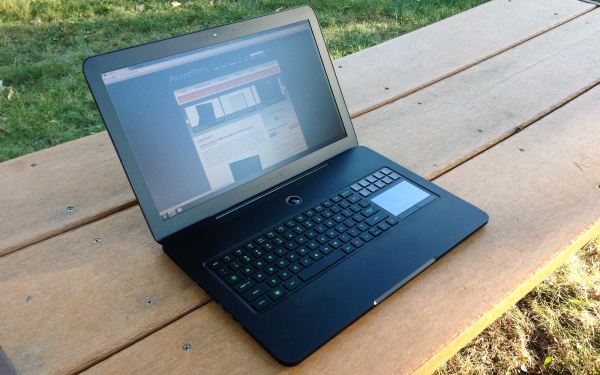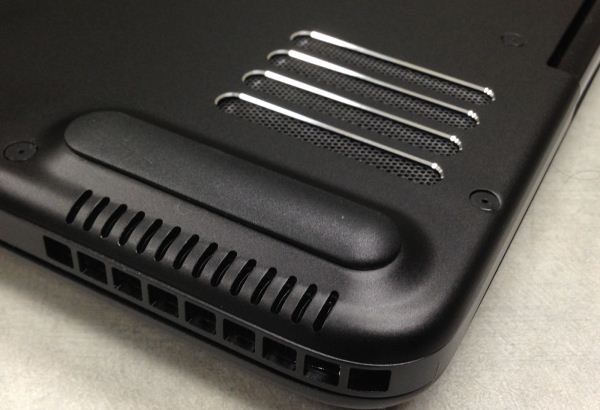The New Razer Blade: Thoroughly Reviewed
by Vivek Gowri on October 3, 2012 5:40 PM ESTRazer Blade (late 2012) - Design Changes
I was a huge fan of the Blade’s design, so I’m perfectly alright with it carrying over mostly untouched. It’s just better looking and better built than a vast majority of other 17” gaming notebooks out there. I’ve used the 17” Ultrabook term before to describe the Blade, and it still applies—it’s got the form factor and design detailing (and the price) that we’ve come to expect from Ultrabook class PCs.
The anodized aluminum unibody is as gorgeous as ever. I spent about a thousand words describing it last time around, and that page of my review perfectly sums up the exterior of the new Blade as well. This is one of the most striking notebook designs to hit the market in recent years. I’ve always loved the detailing on the Blade, from the uniformly green accents (including the USB 3.0 ports) to the two ridges on the back, which interestingly enough, were apparently inspired by the styling of Japanese samurai swords. It’s clean and elegant, but still makes a powerful visual statement. There are few systems out there with the awe factor of the Blade—it’s beautiful and menacing, all at once.
But with that said, there are some changes, predominantly at the bottom of the system. The venting has been changed considerably, with larger vents on the bottom—still the beautiful machined slots with polished aluminum edges and a lighter metal mesh, just with more surface area covered—as well as raised feet in the rear of the system.
This serves two purposes, the obvious one being improved heat dissipation from the bottom of the system due to the presence of significantly more air and airflow underneath. To aid in this, Razer has put in a secondary set of vents on the edge of the underside, next to the raised feet. The other is that adding a space there has allowed Razer to move the CPU heatpipe there, underneath the heatsink. Previously, the copper heatpipe went through the heatsink, impeding airflow, so the change brings about a much freer breathing cooling system.
Every bit of thermal headroom helps with a system as thin as the Blade, and the new thermal design has allowed Razer to add 10-12 watts to the system while still having it run cooler than before. Razer has also changed the fans it used, after complaints from us and others about the noise of the fan when it spooled up, so it’s quieter as well.
The raised feet also give the Blade an ergonomic tilt when set on a flat surface. Of course, it also adds thickness to Razer’s claimed 0.88” height figure, which appears to cover only the body. Including the feet, the Blade is probably closer to 1-1.05” thick.













59 Comments
View All Comments
ahamling27 - Wednesday, October 3, 2012 - link
It was my black Macbook from 2007, only larger and with a weird placement of the trackpad. It's sleek, I'll give them that, but I'd much rather pay for something that's bulky but has more horsepower under the hood. That's all we're really talking about here though, and I'm not willing to choose form over function, not at that price point.danjw - Wednesday, October 3, 2012 - link
Ok, so why bother with a comment? To me it is a good trade off of form factor and functionality. Like Vivek, I would prefer an option for a pure SSD; But it isn't a bad compromise they have gone with.I like the Switchblade to play with as well. Some may find it cumbersome to program, but as a computer programmer, I doubt I will find it so.
Anyway mobile devices are about trade offs, some will fit some peoples styles and others will fit others. it is part of the game.
ahamling27 - Wednesday, October 3, 2012 - link
The point was to start a discussion. I honestly don't see why anyone would pay so much for something when a better spec'd machine can be had for quite a bit less. I understand that it's not easy to cram all that in a rather slim and attractive design, but why should that cost such a premium?Back in 2009 I purchased a Gateway P-7811 FX for 40% of the asking price and it's got a 1920x1200 screen, a 9800m gts, and a dual core 2.26 ghz processor, and that was over 3 years ago! Sure it wasn't .88" thin, and all black, but it wasn't ugly either.
All I'm saying is that for this to be anything but an expensive gimmick, they need to figure out a way to lower their costs.
gelb - Wednesday, October 3, 2012 - link
Well in my opinion, its like this; A Toyota Tacoma cost around 30,000 dollars for a 3.4 liter v6 engine and and a great sleek good looking finish along with a nice attention to detail. Now on the other hand is the around 20,000 dollar Nissan Frontier with a 4.0 liter v6 engine. Now, the Tacoma will give you a lot more features along with nicer finish and machine work to the actual frame and parts, but it lacks the "uumph" the Frontier has with it's 4.0 liter v6 engine. Now another thing that should be taken into account their fuel efficiency. The Tacoma gets a much better fuel efficiency than the Frontier does. So, the Blade in my opinion is the Tacoma and the other brands such as Asus etc. are the Frontier makers. In the Blade, you don't get the same kind of power but you trade it for a better finish/build and sleekness.elhoboloco - Thursday, October 4, 2012 - link
> Toyota> Great design
Pick one.
VivekGowri - Thursday, October 4, 2012 - link
Hahaha. You can make the same argument with the 911 and the Corvette, if that helps. Power and value versus refinement, style, fit and finish, design/build quality, etc.Bob Todd - Thursday, October 4, 2012 - link
Saying the Gateway P-7811 FX wasn't ugly doesn't help your case. It was hideous. I had one for 2 days before returning it for a screen defect. Some people are willing to pay (significantly) more for better materials and build quality. You can get the same CPU/GPU/resolution in a $999 Lenovo Y580. That doesn't make it a better laptop for everyone. One feels premium, the other feels like a tin can. It might not be worth it to you, but not everyone has the same use case and priorities as you. You don't try to build a premium brand (with premium margins) by starting off competing in the hotly contested space between $800-$15000. For me, Vivek was spot on about wanting to ditch caching storage and add IPS at this price point. So while I wouldn't spend $2500 on this, I can absolutely understand others doing so. I'd love to have one, and that's kind of the point from a product perspective.Bob Todd - Thursday, October 4, 2012 - link
If only I could edit...that was supposed to be "basically the same CPU/GPU/resolution", as the Blade obviously has the 3632QM vs. the 3610QM in the Y580.ahamling27 - Thursday, October 4, 2012 - link
The Gateway was far from ugly, but what it looks like is purely subjective and had nothing to do with the point I was trying to make. You actually helped me prove my point with the Lenovo. That's a great laptop there, so why does the Switchblade cost $1500 more?$1500 more for something that "feels premium"? It's a plastic body...
The problem with them making a "premium" product is that they aren't using "premium" parts. They are using middle of the road hardware and calling it "premium". That's what I have a problem with.
ahamling27 - Thursday, October 4, 2012 - link
Whoops, now I'm red in the face, I guess it is made of aluminium , not plastic. +1 Razer, but I'm still standing my point, it woefully overpriced.